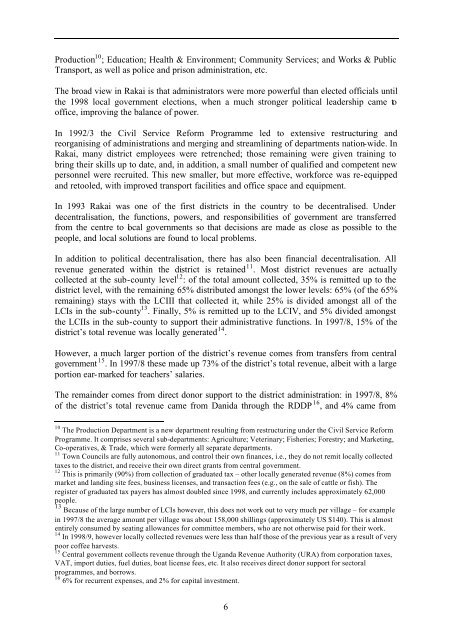Access to Rural Non-Farm Livelihoods - Natural Resources Institute
Access to Rural Non-Farm Livelihoods - Natural Resources Institute
Access to Rural Non-Farm Livelihoods - Natural Resources Institute
Create successful ePaper yourself
Turn your PDF publications into a flip-book with our unique Google optimized e-Paper software.
Production 10 ; Education; Health & Environment; Community Services; and Works & Public<br />
Transport, as well as police and prison administration, etc.<br />
The broad view in Rakai is that administra<strong>to</strong>rs were more powerful than elected officials until<br />
the 1998 local government elections, when a much stronger political leadership came <strong>to</strong><br />
office, improving the balance of power.<br />
In 1992/3 the Civil Service Reform Programme led <strong>to</strong> extensive restructuring and<br />
reorganising of administrations and merging and streamlining of departments nation-wide. In<br />
Rakai, many district employees were retrenched; those remaining were given training <strong>to</strong><br />
bring their skills up <strong>to</strong> date, and, in addition, a small number of qualified and competent new<br />
personnel were recruited. This new smaller, but more effective, workforce was re-equipped<br />
and re<strong>to</strong>oled, with improved transport facilities and office space and equipment.<br />
In 1993 Rakai was one of the first districts in the country <strong>to</strong> be decentralised. Under<br />
decentralisation, the functions, powers, and responsibilities of government are transferred<br />
from the centre <strong>to</strong> local governments so that decisions are made as close as possible <strong>to</strong> the<br />
people, and local solutions are found <strong>to</strong> local problems.<br />
In addition <strong>to</strong> political decentralisation, there has also been financial decentralisation. All<br />
revenue generated within the district is retained 11 . Most district revenues are actually<br />
collected at the sub-county level 12 : of the <strong>to</strong>tal amount collected, 35% is remitted up <strong>to</strong> the<br />
district level, with the remaining 65% distributed amongst the lower levels: 65% (of the 65%<br />
remaining) stays with the LCIII that collected it, while 25% is divided amongst all of the<br />
LCIs in the sub-county 13 . Finally, 5% is remitted up <strong>to</strong> the LCIV, and 5% divided amongst<br />
the LCIIs in the sub-county <strong>to</strong> support their administrative functions. In 1997/8, 15% of the<br />
district’s <strong>to</strong>tal revenue was locally generated 14 .<br />
However, a much larger portion of the district’s revenue comes from transfers from central<br />
government 15 . In 1997/8 these made up 73% of the district’s <strong>to</strong>tal revenue, albeit with a large<br />
portion ear-marked for teachers’ salaries.<br />
The remainder comes from direct donor support <strong>to</strong> the district administration: in 1997/8, 8%<br />
of the district’s <strong>to</strong>tal revenue came from Danida through the RDDP 16 , and 4% came from<br />
10 The Production Department is a new department resulting from restructuring under the Civil Service Reform<br />
Programme. It comprises several sub-departments: Agriculture; Veterinary; Fisheries; Forestry; and Marketing,<br />
Co-operatives, & Trade, which were formerly all separate departments.<br />
11 Town Councils are fully au<strong>to</strong>nomous, and control their own finances, i.e., they do not remit locally collected<br />
taxes <strong>to</strong> the district, and receive their own direct grants from central government.<br />
12 This is primarily (90%) from collection of graduated tax – other locally generated revenue (8%) comes from<br />
market and landing site fees, business licenses, and transaction fees (e.g., on the sale of cattle or fish). The<br />
register of graduated tax payers has almost doubled since 1998, and currently includes approximately 62,000<br />
people.<br />
13 Because of the large number of LCIs however, this does not work out <strong>to</strong> very much per village – for example<br />
in 1997/8 the average amount per village was about 158,000 shillings (approximately US $140). This is almost<br />
entirely consumed by seating allowances for committee members, who are not otherwise paid for their work.<br />
14 In 1998/9, however locally collected revenues were less than half those of the previous year as a result of very<br />
poor coffee harvests.<br />
15 Central government collects revenue through the Uganda Revenue Authority (URA) from corporation taxes,<br />
VAT, import duties, fuel duties, boat license fees, etc. It also receives direct donor support for sec<strong>to</strong>ral<br />
programmes, and borrows.<br />
16 6% for recurrent expenses, and 2% for capital investment.<br />
6

















